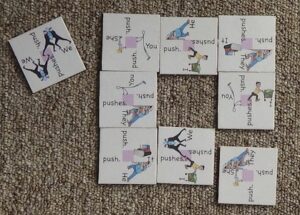
Nine Square (or 9-Square) is a puzzle that is very simple: nine squares that form one larger square.
It’s really simple, but it’s really hard!
Putting the pieces into their proper order takes a lot of trial and error. And in this version of the puzzle—Grammar 9-Square—while the player works to put each piece in its place, they meet a very basic but particularly inconvenient piece of English grammar: the third person singular “s.”
Why is it that we say, “I sit” and “You sit” and “They sit,” but we say “He sits” and “she sits” and it sits”?
Well, never mind why.
But we do, and because there doesn’t seem to be any reason for it, it is difficult for non-native speakers to acquire. It is easy to understand the rule; it is hard to make it an automatic part of one’s language production.
That’s where Grammar 9-Square comes in. Lots of repetition while the language learner is thinking about something else: solving the problem. And because the learner is not thinking about the grammar, but the puzzle, the repetition never gets boring.
Click this link for a PDF of six Grammar 9-Square puzzles . Just print it out and cut along the cutting guide lines to make the puzzles.
TIP: Cut as precisely as you can!
If you want to make the squares (game tiles) a bit nicer—sturdier, and with more heft—here is a video showing how I make mine:
Click this link for the KEY to the six puzzles. I let the children look at this if they need to. This gives them repetitive reading exposure to the target grammar, but, again, it doesn’t get boring because they aren’t thinking about grammar—they are focused on solving the puzzle.
Click this link for a PDF of a student checklist. After a student completes a puzzle, I check to see that it is all correct. (It often isn’t.) Then I check them by saying each pronoun in turn (“She“), to which they respond by saying the whole phrase (“She sits“). Then the student puts a sticker on the verb whose puzzle they have done.
Here is my YouTube video of this game being played: